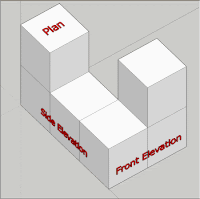正定値と訳される
positive definite(負定値は negative definite)は,一般には symmetric matrix (対称行列=行と列を交換しても等しい行列)に対して使われる用語ですが,IBDP(国際バカロレア Diploma Program)Math の教科書には,「こんな2次関数を positive definite という」と書かれてあります.
Positive definite quadratics are quadratics which are positive for all values of $x$. So, $ax^2+bx+c>0$ for all $x$∈$\mathbb{ R }$ .
Test: A quadratic is positive definite if and only if $a$>0 and Δ<0. (Haese SL P37)
Δはdiscriminant(判別式)です.つまり,常に正の値をとる2次関数を positive definite というわけですが,行列における positive definite の定義との関連を見てみましょう.
[行列の positive definite (正定値) の定義]
n×n対称行列$A$が、n個の成分を持つ零ベクトルでない任意の列ベクトル$\boldsymbol{ x }$に対して、$\boldsymbol{ x }^{T}A\boldsymbol{ x }$($\boldsymbol{ x }^{T}$は$\boldsymbol{ x }$の転置行列)が常に正となるとき,行列$A$は positive definite であるといいます.
[2×2行列で言い換えると]
対称行列$A=\begin{pmatrix} a & b \\ b & c \end{pmatrix}$が,零ベクトルでない任意の列ベクトル$\boldsymbol{ x }=\begin{pmatrix} x \\ y \end{pmatrix}$に対して、quadratic form(二次形式=2次の項だけの式)$$\boldsymbol{ x }^{T}A\boldsymbol{ x }=(x \quad y)\begin{pmatrix} a & b \\ b & c \end{pmatrix} \begin{pmatrix} x \\ y \end{pmatrix}=ax^2+2bxy+cy^2$$が常に正となるとき,この行列A,またはこの二次形式を positive definite であるといいます.
[2次関数に当てはめると]
一般に2変数の2次関数(2次の項+1次の項+定数項)は2×2行列を用いて次の式で表せます.$$\boldsymbol{ x }^{T}A\boldsymbol{ x }+\boldsymbol{ b }^{T}x+c
=(x \quad y)\begin{pmatrix} a_{1} & a_{12} \\ a_{12} & a_{2} \end{pmatrix} \begin{pmatrix} x \\ y \end{pmatrix}+(b_{1} \quad b_{2})\begin{pmatrix} x \\ y \end{pmatrix}+c\\
=a_{1}x^2+2a_{12}xy+a_{2}y^2+b_{1}x+b_{2}y+c$$1変数の2次関数を1×1行列で表せば$$(x)(a)(x)+(b)(x)+c=ax^2+bx+c$$となり,$a>0$で$Δ<0$のとき,positive definite になります.
1変数の2次関数を2×2行列の式で表すこともできます.対称行列$A=\begin{pmatrix} a & \frac{b}{2} \\ \frac{b}{2} & c \end{pmatrix}$と,$x$の値が任意の列ベクトル$\boldsymbol{ x }=\begin{pmatrix} x \\ 1 \end{pmatrix}$で、$$\boldsymbol{ x }^{T}A\boldsymbol{ x }=(x \quad 1)\begin{pmatrix} a & \frac{b}{2} \\ \frac{b}{2} & c \end{pmatrix} \begin{pmatrix} x \\ 1 \end{pmatrix}=ax^2+bx+c$$これが常に正となるとき,positive definite になります.
以上のことから,2次関数の positive definite は,対称行列の positive definite の特別な場合であることが分かります.
ここで,$A$の行列式$|A|=ac-\frac{b^2}{4}=-\frac{1}{4}(b^2-4ac)=-\frac{1}{4}Δ>0$なら$Δ<0$となり,その逆も成り立ちますから,$|A|>0$という条件は$ax^2+bx+c$がpositive definiteであるための必要十分条件になります.
因みに positive definite に似た意味で positive quadratic という用語もあります.
For a quadratic function $f(x)=ax^2+bx+c$:
If a>0, f(x) is a positive quadratic. The graph has a minimum point and goes up on both sides.
(Cambridge SL P2)
If the leading coefficient, a, of the quadratic function $f(x)=ax^2+bx+c$ is positive, the parabola opens upward (concave up)
(Pearson SL P66)
つまり,$ax^2+bx+c$ の $a>0$(下に凸)の場合,この2次関数を positive といいます.
[Reference]
Mathematics for the International Student-IB Diploma: SL
Haese Mathematics
Mathematics for the IB Diploma Standard Level
Cambridge University Press
Pearson Baccalaureate: Standard Level Mathematics for the IB Diploma International Edition
Pearson Education Limited


























